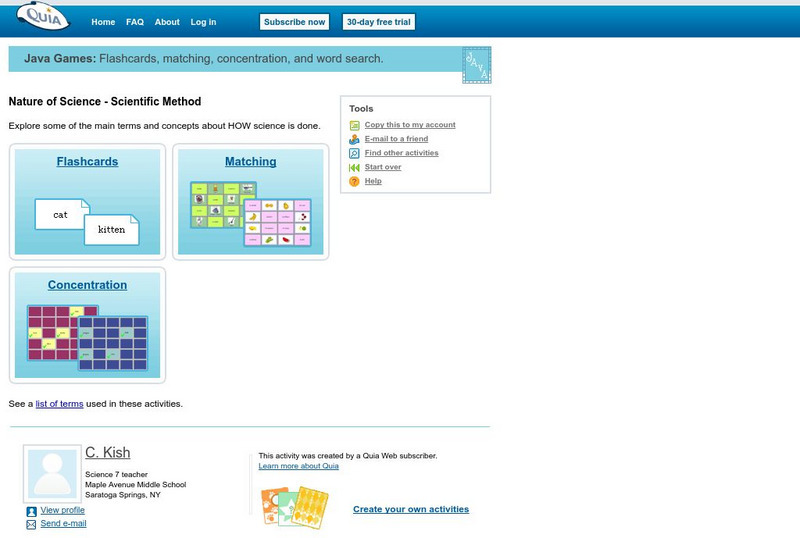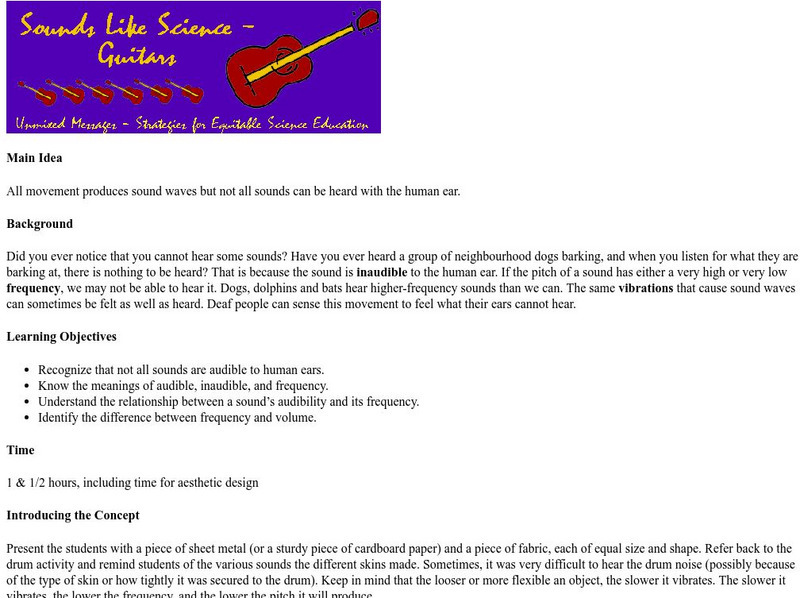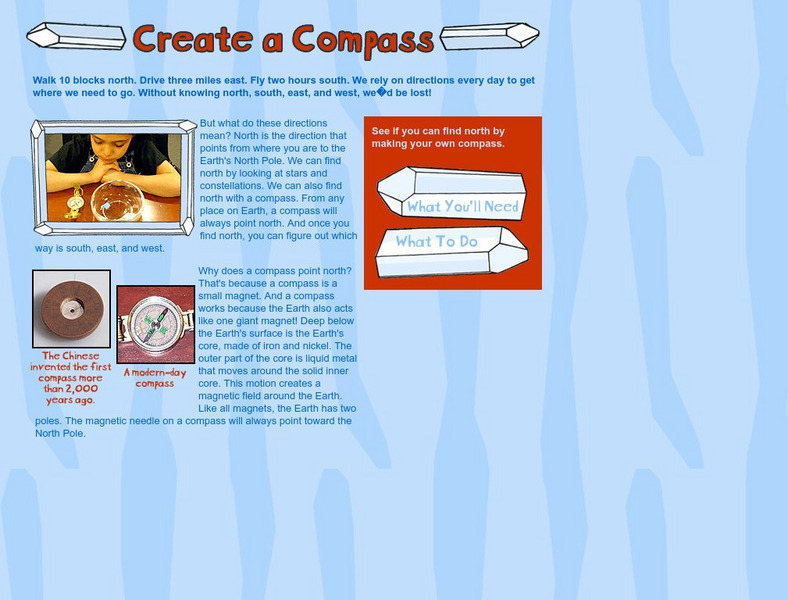Science Education Resource Center at Carleton College
Serc: Rutherford's Enlarged: A Content Embedded Activity on Nature of Science
Through a study of Ernest Rutherford's experiments with atomic structure, learners develop a deeper understanding of the nature of science. The activity is taken from a linked article by the author that was published in the Journal of...
Other
Manitoba Education and Training: Physics: Particle and Wave Models of Light
A collection of ideas for teaching young scholars about the nature of light. They learn about the history behind theories of light and the contributions of different scientists. Includes lots of experiments to build their understanding...
Quia
Quia: Nature of Science Scientific Method Flashcards
Review the nature of science with on-line flash cards.
Quia
Quia: Nature of Science
Find games and flashcards that students can use to learn the words associated with the scientific method.
Quia
Quia: Nature of Science Scientific Method Concentration
Play a game of concentration by matching terms used in the scientific method to their proper description.
Other
Teaching Ideas for Primary Teachers: Science Ideas
A great resource to discover fun new activities to use in your classroom. Activities are age-appropriate, and span several science topics.
American Museum of Natural History
American Museum of Natural History: O Logy: Stuff to Do: Dna in a Blender
Follow these illustrated instructions to conduct a simple experiment in separating DNA from an onion!
Science Museum of Minnesota
Science Museum of Minnesota: Thinking Fountain: Friction
The Thinking Fountain provides this simple experiment for understanding friction and it relationship to energy.
CommonLit
Common Lit: "A Teen & a Trolley Reveal Society's Dark Side" by Bethany Brookshire
In 2015, a high school senior named Tiffany Sun conducted a social science experiment and presented her results at the Intel Science Talent Search in Washington, D.C. The results of her experiment shed light on an age-old question: are...
Alabama Learning Exchange
Alex: Nocturnal Animals Lesson #7: Spiders
In this lesson plan learners will learn the body parts of a spider and write addition/subtractions sentences using spiders. The class will go on a nature walk to find spiders and spider webs. Finally, the students will complete a science...
Society for Science and the Public
Science News for Students: Nature Resets Body's Clock
Article reports on a recent study which found that people who spent a week in the woods experience a shift of two hours in their internal clocks. Includes a list of vocabulary words from the article.
BBC
Bbc News: 'Big Bang' Experiment Starts Well
Watch a narrated animation on the Large Hadron Collider, its experiments, structure, and computer system. Then, browse this site's sections to explore facts about and functions of CMS, ATLAS, ALICE, LHCb, the LHC Computing Grid, and the...
CK-12 Foundation
Ck 12: Life Science: Evolution Acts on the Phenotype
[Free Registration/Login may be required to access all resource tools.] Natural selection acts on the phenotype (traits or characteristics) of an individual. On the other hand, natural selection does not act on the underlying genotype...
ArtsNow
Arts Now Learning: Realizing the Power of Your Own Creativity [Pdf]
In this lesson, students interpret a poem called 'The Little Blue Engine' by adding music, movement, visual art, and drama. After performing their creation, they will discuss any mathematical and/or scientific connections that have a...
Discovery Education
Discovery Education: Science of Everyday Life: Oil Spill Clean Up [Pdf]
In this lesson plan learners experiment with cleaning up an oil spill. This lesson begins with students learning about the effects of oil spills on the natural environment. Then learners will explore the most effective way to clean up an...
Science Education Resource Center at Carleton College
Serc: Mn Step: Sponge Lab: Experimenting With Absorption
Students investigate the properties of synthetic and natural sponges in this activity, to determine the capacity of each to absorb water. Afterward, they discuss other questions they have about sponges, and complete an assessment in...
Harvard University
Harvard Smithsonian: Everyday Classroom Tools
The focus of this series of lessons is to engage students in an exploration of the world around them. The emphasis is on inquiry as students learn about the earth, sun, light, shapes and more.
Museum of Science
The Atoms Family
Let this classic family of monsters guide you as you learn about energy. Interactive exercises, experiments, and demonstrations help to build knowledge and raise questions.
Michigan Reach Out
Sounds Like Science: Guitars
At this site explore the relationship between audibility and frequency of sound, and the difference between frequency and volume.
ReadWriteThink
Read Write Think: Reading/writing About Whales Using Fiction and Nonfiction Texts
Students will have a whale of a good time in this lesson in which they use fiction and nonfiction texts to write a letter to an online scientist.
Woods Hole Oceanographic Institution
Woods Hole Oceanographic Institution: Tsunami: An Interactive Guide
A complete, interactive learning activity covering the science of tsunamis, preparedness, research, and historical tsunamis. Excellent animations and real, historical recordings of survivors allow the learner to experience what happens...
Wisc-Online
Wisc Online: The Mad Scientist
Review different parts of the scientific method in this hangman-style game.
American Museum of Natural History
American Museum of Natural History: O Logy: Stuff to Do: Create a Compass
Step-by-step illustrated instructions for building a compass and testing its accuracy.
Other
Manitoba Model Forest Network: Interaction Within Forest Ecosystems [Pdf]
This comprehensive Grade 7 Science unit has three chapters on forest ecosystems, natural cycles in a forest, and human interactions with a forest. Each chapter has experiments, activities and questions complete with answers. There are...

















